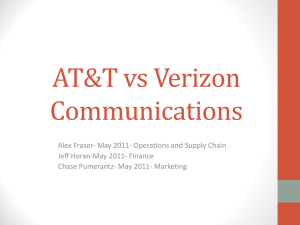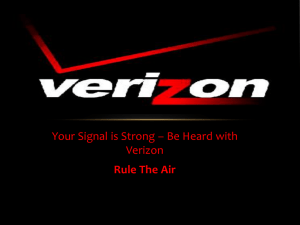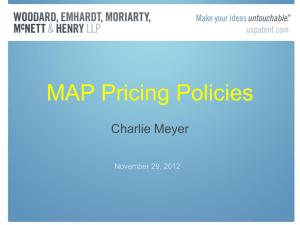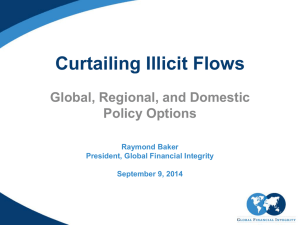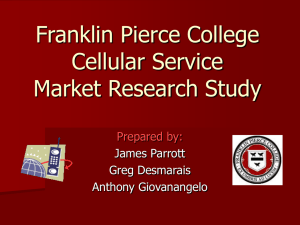Penalty Pricing
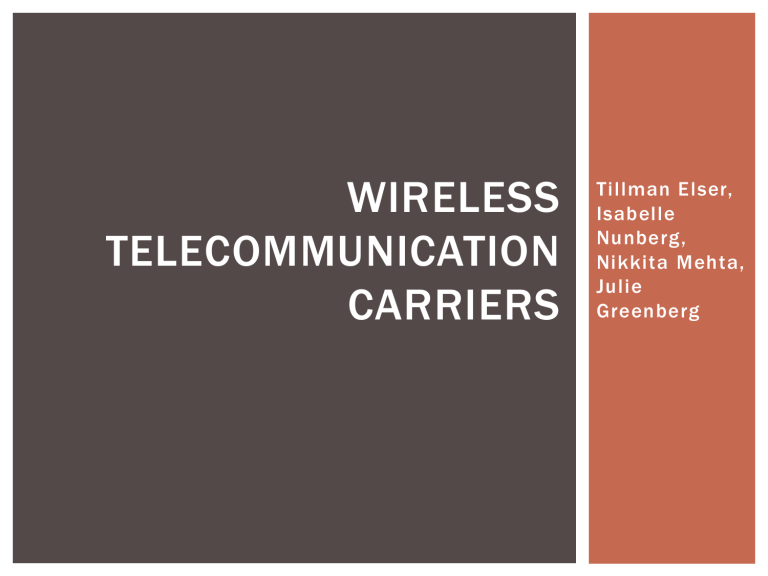
WIRELESS
TELECOMMUNICATION
CARRIERS
Tillman Elser,
Isabelle
Nunberg,
Nikkita Mehta,
Julie
Greenberg
AGENDA
The Industry
• General Background
• Consumers
• Main Players
• Competition
Pricing Strategies
• Bundling and Versioning
• Three Part Tariff
• Network Externalities
• Tacit Collusion
• Penalty Pricing
• Discounts
• Cell phone pricing
Recommendations
• Investments
THE INDUSTRY
• - General Background
• - Consumers
• - Main Players
• - Competition
PRIMARY PRODUCTS
Wireless voice communication
Text Messaging services (SMS)
Advanced PCS
(personal communication services)
Other data services
Other wireless services
INDUSTRY SNAPSHOT
Lower pricing -> competitive advantage over wired services
Consumers embracing newer/more expensive technology
Retail presence decreasing in importance
IBISWorld
PRIMARY CONSUMERS
Corporate clients (15%)
Stable market characterized by long term contracts and predictable patterns of usage
Most concerned with reliability (voice) and speed (data)
Big target for 4G technology
Small/Medium Businesses (30%)
Laptop data plans and fixed mobile services attractive to this market
General consumer/residential clients (55%)
Most price sensitive
Demand growing fastest in this group
DIFFERENTIATION AMONG CONSUMERS
Heterogeneous preferences for cell phone usage
High use
Low use
Focus on Data
Focus on Voice
Focus on Text vs
WHY PRICING BEYOND MINUTES IS
IMPORTANT.
EXPENSES BREAKDOWN
24.8% - Cost of service
14.5% - Depreciation
12.5% - Equipment
Purchases
8.4% - Wages
5.9% - Advertising
6.7% - Rent/Utilities fees
6.5% - Profit
~20% other expenses
30,00%
25,00%
20,00%
15,00%
10,00%
5,00%
0,00%
NETWORK TECHNOLOGY
1G
Analog, usage stopped in 2008
2G
Basic voice and data functionality
Popularity declining as newer standards develop
14.4Kb/s
2.5G
Stepping Stone from 2G to 3G
50-150Kb/s speed
Wireless Application Protocol (WAP) mobile Internet as well as
MMS
Most advanced iteration of 2.5G is the EDGE network (AT&T/T-
Mobile)
200-1000Kb/s
NETWORK TECHNOLOGY (CONT.)
3G
Current standard among smartphones
Beginning to assume market dominance from 2G and
2.5G
Speeds of 300-600Kb/s
3.5G
Middle ground between 3G and 4G
Speeds up to 14.4Mb/s
AT&T/T-Mobile
4G
Epitomizes shift from voice to data among telecommunications carriers
Conflict between WiMax (Sprint) and LTE (Verizon) standards
Speeds up to 100Mb/s for mobile devices (1Gb/s for stationary devices)
MARKET CONCENTRATION
Trends of M&A
Method to gain subscribers and coverage
Saturated market: harder to build new customer base
Economies of scale
Higher margins and available capital enable firms to invest in their networks and services
MARKET CONCENTRATION
Top 4 Firms Market Shares:
Verizon Wireless: 33.4%
AT&T Inc.: 31.2%
Sprint Nextel Corporation: 16.2%
Deutsche Telekom AG (T-Mobile): 11.0%
CR4 = 91.8
HHI = 2472.44
VERIZON WIRELESS
33.4% of market (market leader)
Part of Verizon Communications– VW contributes almost 2/3 of revenue
Originally merger of three companies
Acquired Alltel in 2009 to give VW largest market share in industry
Now transitioning to 4G LTE
Revenue growth of 11.7% annually over past 5 years
In 2011, expected to generate $66.1 billion in revenue and net income of over $4.4 billion
AT&T INC.
31.2% of market
Largest market share until Verizon-Alltel merger
Started as joint venture called Cingular Wireless
In 2006, AT&T acquired both companies and became
AT&T Inc.
AT&T wireless contributes to ½ of company revenue
Plans to acquire T-Mobile within next 12 months
Problem of congestion on data networks
Revenue growth of 10.3% annually over past 5 years
In 2011, expected to generate $61 billion in revenue and net income of $16.5 billion
SPRINT NEXTEL CORPORATION
16.2% of market
Sprint and Nextel merged in 2005
Only major company losing subscribers
Backs WiMax instead of LTE for 4G network
Annual revenue decline of 4.1% and has failed to turn a profit since 2006
T-MOBILE
11% of market
Brand of Deutsche Telekom AG in US
First wireless carrier to offer Android phones
Large carrier of WiFi with T-Mobile Hot Spots
Plans for AT&T to acquire T-Mobile
In 2011, will generate $28.2 billion in revenue and net income of $1.8 billion
COMPETITION
HIGHEST in whole telecommunications sector
WHY?
Churn rate of 1.5% to 3.5% per month
Types:
Price
Service offerings & quality of service
Product innovation
Network dependability and call quality
Marketing strategies
Geographic coverage
COMPETITION:
PRICING
Firms all offer similar products, coverage, and services price competition is vital
Try to undercut competition
Discounts, network externalities, etc.
Partly enabled by recent M&A activity by improving firms’ economies of scale
COMPETITION:
SERVICE OFFERINGS & QUALITY OF
SERVICES
Service becomes important weapon in the industry as customers increasingly value reliability and attention
High investment in upgraded technologies and networks
Customer service becomes vital in gaining customer loyalty and reducing churn rates
Expansion of service offerings: “one-stop” bundles
Telecommunications Act of 1996
COMPETITION:
PRODUCT INNOVATION
New technologies incredibly useful in increasing usage, margins, and customer base
Short life cycles for products and applications
New technology includes:
GPS mapping
TV feeds
E-commerce . . .
3G 4G
COMPETITION:
MARKETING STRATEGIES
Promotional tactics
Rebates, discounts, etc
Advertising
Supply side: Combative advertising
Mature market; goal is to shift consumer demand toward advertising firm but not expanding consumer demand
Demand side
Persuasive: alters consumers tastes based on service providers’ attributes, strengthens barriers to entry especially in industry with economies of scale
Complementary: appeals to “social prestige” with new phones, appeals to attributes complementary to use (coverage, overage, etc.)
COMPETITION:
GEOGRAPHIC COVERAGE
Ultimate goal: maximum US nationwide coverage
Enables furthering economies of scale and higher efficiency
Over 277 million Americans (approx. 91%) can choose between three or more providers while 250 million of those
Americans (approx. 82%) can choose between only top four
EXTERNAL COMPETITION
Mobile virtual network operators (MVNOs)
Companies that purchase airtime from a major wireless network then resell it with their own logo
Increasing as communications and media leaders have recognized potential growth
Mobile strategies developed by
Comcast and Time Warner
Cable
Google looked into bidding in
700MHz auction in 2008
BARRIERS TO ENTRY
Barriers to entry are high and increasing primarily due to…
Regulating spectrum scarcity
High costs
Market saturation
BARRIER:
SPECTRUM SCARCIT Y REGULATIONS
Spectrum scarcity refers to a finite number of companies being able to operate cellular/PCS services with a designated geographic location and frequency
Distributed through licenses within a specified area
Closed to new entrants until next auction
Cost at time of auction is high; over $19 billion was spent in 2008
700 MHz auction
BARRIER:
HIGH COSTS
High initial costs
Base stations, towers, and other necessary infrastructure reaches the billions
Costs of R&D and other investments
Dependency on product innovation and up-to-date technologies
Marketing strategies
BARRIER:
MARKET SATURATION
Existing firms already established their strong positions
Cost advantages due to economies of scale
Ability to spread expenses over large customer base
“one-stop” bundles differentiate from pure wireless providers and reduce churn rates
Slowing growth in customer base
PRICING STRATEGIES
• - Bundling and Versioning
• - Three Part Tariff
• - Network Externalities
• - Tacit Collusion
• - Penalty Pricing
• - Discounts
• - cell phones
BUNDLING AND VERSIONING
Feature bundling on cell phones -> facilitates feature bundling on contracts
Customers pushed onto smart phones
Increases access to additional features
Versioning
Family plan vs Individual plan
Extensive bundling seen in cell phone plans
Considerable variance between companies
Common themes: Avoid pure bundling, target heterogeneous preferences
Focus on mixed bundling
Most profitable bundles listed more prominently
In some cases, no price difference between bundled and non bundled services
Customer ‘opts-in’ to services
AT&T
Pure and mixed bundling
Similar services grouped together
Customer forced to
‘opt-out’ of some services
Fewer options than
AT&T, but still many additional services offered
Minutes and text packages offered as initial service bundles
Can also add text package after choosing minutes
VERIZON
Lower utilization of mixed bundling, focus on pure bundles
Customer required to opt-in to several free services
Huge number of bundles -> confusion pricing
T-MOBILE
Focus on pure bundling
Search obfuscation used more prominently
(‘premium data addon)
Fewest additional service options
SPRINT
THREE-PART TARIFFS
Monthly fee and per minute fee
Now, mostly three-part tariffs: monthly fee with included minutes but high overage fee
Customers choose three-part tariff over twopart tariff because of flat-rate bias
Most customers underestimate usage (use only half of minutes allowable on average)
Those that do exceed allowance, exceed by
40% on average
CONFUSION PRICING
Many versions so consumer surplus extracted from those less willing to search for correct plan
Customers underestimate uncertainty about usage
(overconfidence) by 81% and underestimate volatility of usage (projection bias) by 57%
When first signing up, average customer underestimates usage by 40%
Companies gain an average of $60 per customer
Slow to correct mistake and switch plan
AT&T “rollover” plan targets sophisticated consumers who understand that usage changes monthly
PLANS AND ADD-ONS
30
25
20
15
10
5
0
AT&T Verizon T-Mobile Sprint
Plans
Add-Ons
NETWORK EXTERNALITIES
Companies create network externalities as an incentive to gain new customers
Free texting within Verizon network
Free minutes within all networks
Only significant after critical mass reached
Customers benefit from others on the same network
The greater the size of the network, the greater the benefit to user
TACIT COLLUSION
How does it work?
Industry is an oligopoly
Top four firms dominate almost the entire market
Homogenous products
Same phone (e.g. iPhone from AT&T or
Verizon?), data services (text, e-mail, etc)
Agreement on price is easier to come by and cheating is easier to catch
Nondurable goods
Less incentive to cheat because it is a one -time sale product rather than a product from which sellers could gain a series of sales
TACIT COLLUSION:
PRE-ANNOUNCED RATE CHANGES
Service providers typically preannounce rate changes they plan on implementing
Advanced notice gives competing firms time to respond
Can test the market and competitors
TACIT COLLUSION:
INFREQUENT HIGH CHANGES IN RATES
Rate changes in the industry have been high and infrequent, yet coordinated across all four firms
FOCUS: Text Messages
Supply is almost unlimited so in a competitive market prices should decrease not increase over time
Since 2005 price per text has doubled. IBISworld
Service providers do not claim that these increases were driven by higher costs so other methods must be at work.
Doubling of prices pushes prices from inelastic portion of demand curve to elastic portion to capture unrealized revenue
PENALT Y PRICING: THE “T YPICAL”
CONSUMER
Overconfident
Unattentive
• Barriers of Adoption
• Unpredictability of use
• Profit Margin due to over and under usage.
Underestimates
Minutes
Verizon
.40-.45
T-Mobile
.45
Sprint
.40-.45
AT&T
.40-.45
SMS/MMS
Verizon
.20/.25
T-Mobile
.20
Sprint
.20/.25
AT&T
.20/.30
THE FEES:
Sources:
VerizonWireless
.com
ATT.com
Sprint.com
T-mobile.com
About 16.5 million people exceed their cell phone minutes every month in the US
(according to cellknight.com)
In 2005, Minute-Watch.com show that if the average family took their cell phone overage charges and invested them in a standard index mutual fund
(yielding 10.65%) for 22 years, they would have over $19,500 enough to send a child to many state colleges for two years.
AN IDEA…
NUMBERS
WISE
DISCOUNTING
Penetrative
Competitive
Permanent
VERIZON VS. AT&T IN ITHACA
Sprint(above) Verizon(below)
Advertized coverage
All claim
GREAT reception.
What drives consumers to pick one over the other?
T-Mobile(above) AT&T(below)
Peak and Off-
Peak Pricing
Incentive to reduce the quantity of users on the network at high times and spread them out over other times which saves them infrastructure costs and prevents overloads
Started out as different rates for different times
Evolved to the free nights and weekends
AT&T Data network
• Fast growing
Too high usage
• Sole control of the iPhone market and large option of data phones
Network
Crash
• Not prepared for such high usage
Eliminate
Unlimited plans as a new option
• Grandfathering the previous plans
CELL PHONE MANUFACTURER MARKET
CELL PHONES AS A PRICING STRATEGY
Bundling
Tying
Contract
Specific plans/add-ons
Inter-temporal price discrimination
Network
Externalities
Subsidized
INVESTMENT AND
RECOMMENDATIONS
INVESTMENT
Venture Capitalist
High barriers to entry
Competitive advantage of established firms
enter market as a (Mobile Virtual Network Operator)
Focus on attractive data packages
Stock Market Analyst
Voice and SMS capabilities and prices maturing
Future success dependent on 4G deployment
Verizon: Invest
RECOMMENDATIONS
Race to 4G
Carrier with the most comprehensive 4G network secures a substantial competitive advantage
Utilize Network Externalities Data usage
Data usage within network free (non unlimited plans)
iPhone live?
Subsidize
Consumers more willing to accept expensive plans when high tech smart phones more accessible
Reach for the Cloud(s)
Improvements in networks’ data capabilities Cloud computing
Huge potential market, especially among corporate clients
Further use of network externality
QUESTIONS/INFOGRAPH
IC
ht t p://www.as
hwo r thcreative
.c o m/blog/wp c o ntent/uploa ds/2 011/02 /c el l phone_usag e.j pg
